Examining the different gun types, how they work, and the terminology associated with them – useful for your next firearms case.
Parts of a Gun
Action: The ‘heart’ of the firearm, where everything important and complex is happening. This is where the ammunition gets loaded, fired, and ejected.
Barrel: The metal tube that the ammunition travels down and is projected from. The barrel also acts as a way to point or aim the gun.
Bore: The inside of the barrel.
Muzzle: The open end of the barrel.
Stock: The part of the gun that you hold or, in the case of rifles, shotguns and machine guns, press against your shoulder.
Chamber: The section of the barrel where the cartridge is stored just prior to being fired.
Hammer: Strikes the firing-pin or the cartridge primer when the trigger is pulled.
Firing Pin: Strikes the primer of the cartridge when the trigger is pulled, making the bullet shoot down the barrel.
Magazine: Holds cartridges, stores them, and feeds them into the chamber of the firearm. Can be internal or detachable.
Clip: A storage device used to load ammunition into the magazine, speeding up the reloading process.
Shell: A more common name for a shotgun cartridge.
Shot: Small pellet-like spherical projectiles contained in a shotgun shell.
Safety: A mechanism used to help prevent the accidental discharge of a firearm.
Sear: A small catch that the trigger hooks onto, preventing the trigger from firing multiple cartridges on one discharge.
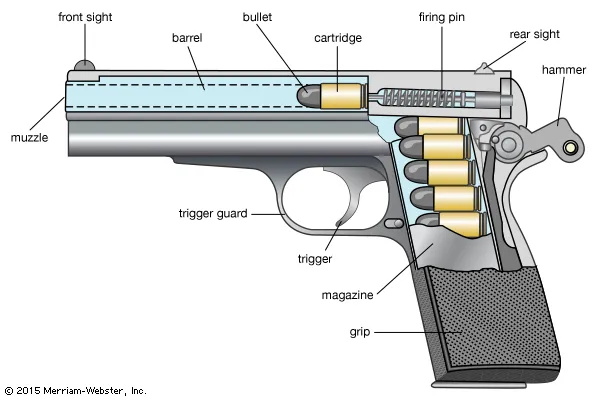
Terminology
Rifling: Spiral grooves inside the bore, giving the ammunition a spin as it comes out of the barrel, and increasing shot accuracy.
Caliber: The nominal bore diameter of a firearm.
Cartridge: Pre-assembled firearm ammunition, usually consisting of primer, casing, powder, and bullet.
Muzzle Velocity: The speed of a projectile with respect to the muzzle at the moment it leaves the end of a gun’s barrel.
Muzzle Energy: The kinetic energy (destructive potential) of a projectile as it leaves the muzzle.
Single-action: The trigger does one thing – fires the gun. The hammer must be pulled back manually before pulling the trigger.
Double-action: The trigger does two things, pulling the hammer back and firing the gun.
Double-action only (DAO): The gun does not have a hammer. Instead, it racks and fires the weapon without there being a visible hammer.
How a Gun Works
A cartridge is loaded into the chamber. When the trigger is pulled, the hammer or firing pin strikes the primer cap of the cartridge. The explosive priming mixture in the cartridge is thereby crushed, causing it to explode. This sends a small flame through the flash hole and into the cartridge case, which ignites the propellant or gunpowder within the cartridge casing. The propellant/gunpowder compound burns extremely quickly and causes gas inside the cartridge to expand rapidly. The expanding gas forces the bullet free from the cartridge casing, sending it speeding down the barrel.
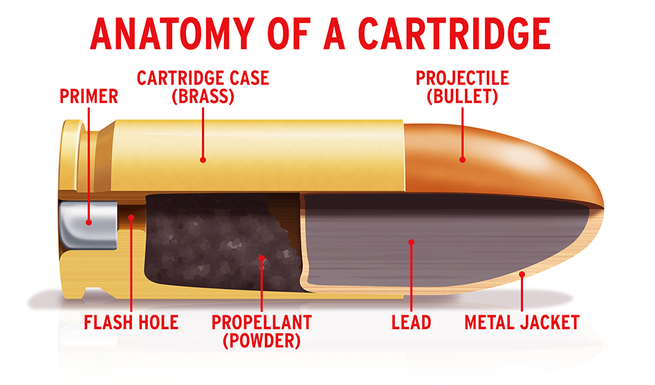
Gun Types
Handgun
So-called because it can be held and fired with one hand. All handguns are fed by a detachable magazine.
Full-size: Barrel 4.5 – 5 inches long.
Compact: Barrel 3.5 – 4.5 inches long.
Sub-compact: Barrel less than 3.5 inches long.
Micro-compact / pocket: Barrel less than 3 inches long.
Revolver
Different from a handgun in one way – ammunition is contained in a cylinder (the ‘wheel’) which revolves on each firing.
Revolvers can fire different calibers.
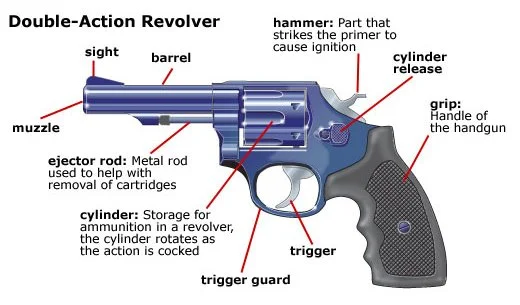
Rifle
Intended to be fired from the shoulder, and fires a single projectile through a rifled bore.
Lever-Action: A tube (the ‘tubular magazine’) runs alongside the barrel. There is a handle behing the trigger that is pulled back to pull a cartridge from the tubular magazine into the chamber.
Bolt-Action: A small metal bar (the ‘bolt handle’) sticks out of the gun above the trigger and behind the chamber. With four motions of upward, backward, forward and down, three things will happen: the last cartridge is ejected, a new cartridge is loaded, and the chamber is closed and ready to fire.
Semi-Automatic: Fire one round by pulling the trigger, with no need to manually re-load the chamber. These rifles commonly use a magazine or clip.
Break-Action: Partially break in half at the chamber. The gun hinges open to allow for manual loading or unloading of cartridges.
Air Rifles: Cartridges are projected by air-pressure or gas. Different types include spring-poweres, gas poston, precharged pneumatic (PCP), variable pump, and CO2-powered.
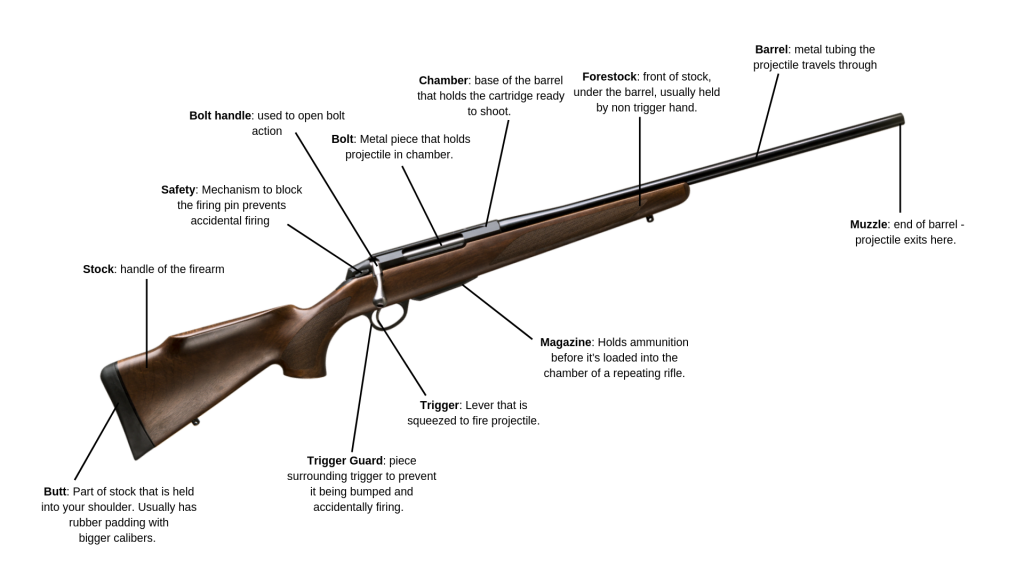
Shotgun
Intended to be fired from the shoulder, and fires multiple projectiles (called ‘shot’) through a smooth bore.
Break-Action: Partially break in half at the chamber. The gun hinges open to allow for manual loading or unloading of shells.
Lever-Action: A tube (the ‘tubular magazine’) runs alongside the barrel. There is a handle behing the trigger that is pulled back to pull a shell from the tubular magazine into the chamber.
Pump-Action: A tube magazine under the barrel carries multiple shells. By pulling back on the forestock and then pushing it forward, the spent shells are ejected and new shells are chambered.
Semi-Automatic: Fire one round by pulling the trigger, with no need to manually re-load the chamber.
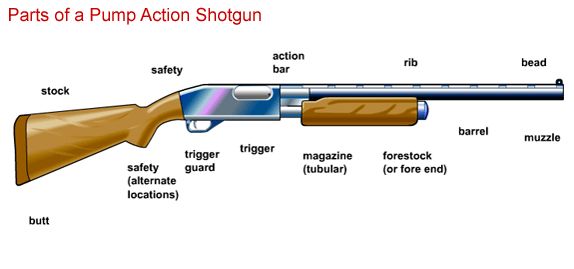
Machine Gun
A fully automatic weapon – when the trigger is pulled the firearm will repeatedly fire ammunition until the trigger is released.
Submachine Gun: An automatic weapon chambered in a pistol or handgun caliber.
Heavy Machine Gun: Generally mounted to some sort of carrier or similar device, and usually fed by a belt of ammunition instead of a magazine.
Light Machine Gun: Designed to be carried by a single person, using rifle bullets in a belt or sometimes in a magazine.
Assault Rifle
Classified as a machine gun because of their automatic firing capacity, assault rifles differ from machine guns in that they have the option of a semi-automatic mode, a three-shot burst mode, and an automatic mode.